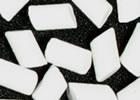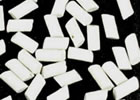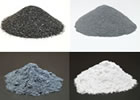Magnesite for Rock Tumbling and Cabbing
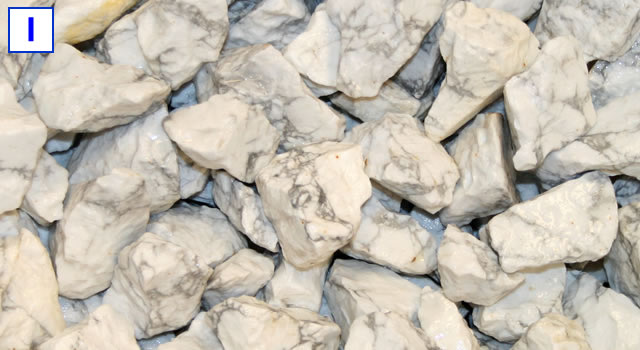
This image shows a bag of magnesite rough, dumped into a colander and sprayed with water to reveal its full color. Click on the image for a larger view. This rough shapes quickly in a tumbler and produces beautiful white tumbled stones with gray webbing.
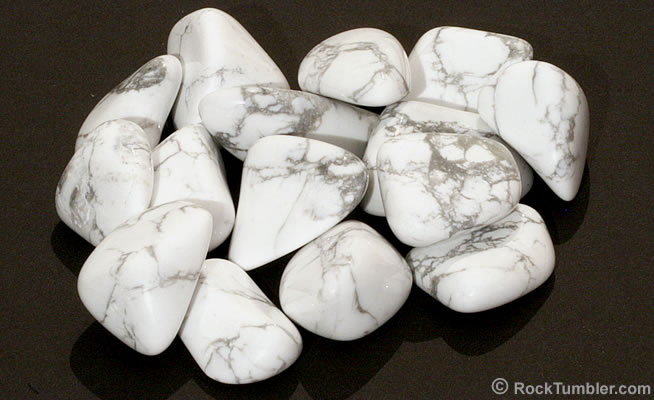
Here are some pieces of our rough magnesite that were tumbled using the Rock Tumbling Recipe below.
Magnesite Tumbling and Cabbing Rough
 ,
,  , and
, and  What do they mean?
What do they mean?
Size: mostly 1/2" to 2" pieces
White, Cryptocrystalline, Silicified
This magnesite from Zimbabwe is perfect for rock tumbling because it has a very fine grain size and is slightly silicified. The silicification makes it a bit harder than pure magnesite, and the very fine grain size enables it to be tumbled into smoothly rounded stones without cleaving. Pure magnesite has a Mohs hardness of 3.5 to 4.5. This material has a hardness of 5+. That allows it to be easily polished in a rock tumbler using TXP aluminum oxide polish or most other popular rock polishes.
INTERMEDIATE Rock Tumbling Recipe:
Silicified Magnesite (1/2 to 2 inches)
When tumbling this magnesite two things should be considered:
1) Shapes Quickly: This material has a Mohs hardness of 5+. That means it will require a little less time in the first grinding step than the agate, jasper, and quartz materials that most people tumble.
2) Media Needed: This material is in pieces that range between 1/2" and 2" in size. For that reason, ceramic media should be added to fill the voids between the pieces of rough. These will provide a smoother tumbling action and deliver grit to the surfaces of the larger pieces of magnesite. We would tumble a mixture of about 25% media (or small rough) and 75% magnesite. Additional media should be added after the first tumbling step if the barrel volume drops below recommended levels.
Recipe for Rotary Tumbling
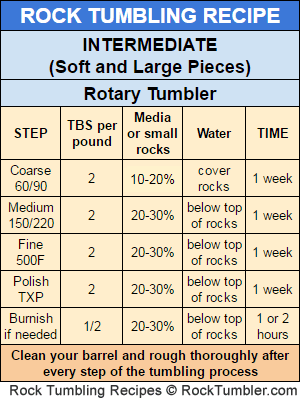
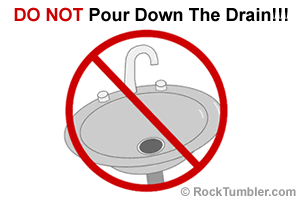
Barrel slurry dumped down the drain will harden like concrete.
Coarse Grit Step: Fill your barrel 2/3 full of rough and media (or small rough). At least 10% to 20% of the material in the barrel should be ceramic media or small-size rough. Then add 2 tablespoons of coarse (60/90) grit per pound of material in the barrel (rough + media). Add enough water to cover the rocks and tumble for one week.
Medium Grit Step: Put your cleaned rough and media back into the barrel. If the barrel is less than 2/3 full, add additional broken-in media to get the barrel up to its proper operating level. Then add 2 tablespoons of medium (150/220) grit per pound of material in the barrel. Finally, add enough water to put the water level just below the top of the rocks. Then tumble for 1 week.
Fine Grit Step: After clean-up, put the rocks and media back into the barrel with 2 tablespoons of fine grit per pound of material, and enough water to bring the water level up to just a little below the top of the rocks. Tumble for one week. Your rocks should be really smooth after this step.
Polish Step: Make sure that your barrel and rough/media mix have been cleaned thoroughly of all grit and rock mud. Then place the rough and media in the barrel with two tablespoons of TXP polish for each pound of material in the barrel. Then add enough water to almost cover the rocks. Tumble for one week.
Burnish If Needed: If you have done a good job of tumbling, this tumbled magnesite will have a nice soft glow. It will not have the "glassy" polished luster that you can produce on agate. Burnishing will probably not be needed, but if you want to clean up the rocks, you can find the full burnishing instructions here.
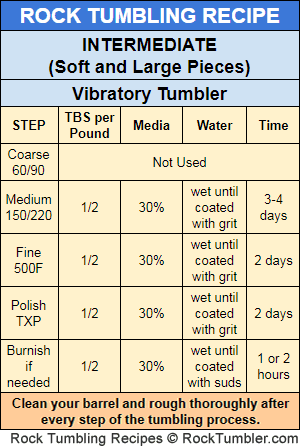
Vibratory Tumbler Recipe:
1/2" to 3" softer rough
Coarse Grit (60/90 Mesh):
Coarse grit is not used in a vibrating rock tumbler.
Medium Grit (150/220 Mesh):
Due to the size of this material, it is recommended that you start with a minimum of 30% ceramic media. The use of this media will aid in the tumbling action in the barrel and help deliver grit to all surfaces of the rough.
After you have your bowl loaded to the manufacturer's recommended level, add 1 tablespoon of grit for every two pounds of material, including the media, in the bowl. While the tumbler is running, slowly add water until the material has a thin coat of wet grit and the tumbling action is smooth and fast in the bowl.
Check the bowl every 8-12 hours to ensure the action is still good. If the action has slowed, add water a little at a time until the action is back to normal. If the mud gets too thick, you will need to do a complete rinse of the material and bowl. After rinsing, add fresh grit and water and start tumbling again. You are done with medium grit when you are satisfied with the shape and smoothness of the stones. Usually 3-4 days for us with this material. Give the material and bowl a thorough cleaning before moving on to fine grit.
Fine Grit (500F Mesh):
Place your material back in the tumbler bowl, then add enough polished ceramic media to bring the load up to the manufacturer's recommended operating level. Add one tablespoon of grit for every two pounds of material in the bowl. Then, turn the tumbler on and slowly add water until the material has a thin coat of wet grit and the tumbling action is smooth and fast in the bowl.
Open the bowl every 8-12 hours to check that the action is still good. We usually run fine grit for 48 hours. Thoroughly clean the bowl and material before moving to the polishing step.
Polish (#61 Rapid Polish or TXP):
Place the cleaned material back in the bowl. If needed, add ceramic media that has been previously polished, to bring the bowl up to the manufacturer's recommended operating level. Add one tablespoon of polish for every two pounds of material in the bowl. Turn on the tumbler and slowly add water. Stop adding water when the material has a thin coat of wet polish and the tumbling action is smooth and rapid.
Like the previous grit steps, open the bowl every 8-12 hours to check the tumbling action. Add water if it has slowed. We have found that 48 hours is usually all the time you need to get a good polish in a vibratory tumbler. Any more time than that, and you run the risk of damaging / bruising the material.
Burnish If Needed:
This rough will usually take a polish with a soft glow; it will not have a super-shiny or "glassy" luster like that of agate or jasper. However, burnishing this material after the polish step can often improve the look of the finished stones. If you would like to try burnishing to see if it improves the look of your polished stones, full burnishing instructions can be found here.
Howlite and Magnesite Are Often Confused
Magnesite and howlite can have very similar appearances. They are so similar that they are two of the most commonly confused and misidentified materials in the lapidary trade - but they are completely different minerals. Howlite is a calcium borosilicate hydroxide with a chemical composition of Ca2B5SiO9(OH)5. Magnesite is a magnesium carbonate with a chemical composition of MgCO3.
If you have a refractometer and know how to test for birefringence blink, you can confirm that this material is magnesite and not howlite. To do that you will test a polished tumbled stone for its spot refractive index and use a polarizing filter to check for birefringence blink. You should obtain a spot refractive index of approximately 1.52 to 1.70 with birefringence blink. This is consistent with magnesite. Howlite's spot refractive index is approximately 1.59, and it never exhibits birefringence blink.
If you want to go one step further, check the specific gravity. We found the specific gravity of this material to be about 2.9, which is slightly less than the 3.00 expected for magnesite - but remember that this material is slightly silicified, and quartz in the material would slightly lower its specific gravity. However, the specific gravity of howlite is about 2.6. This material is not howlite.
Fine Grain Size Eliminates the Cleavage Problem
Magnesite sometimes has perfect rhombohedral cleavage - just like calcite. That type of material would be extremely difficult to tumble into nice polished stones. However, when the crystal size is small enough, the cleavage does not present a problem in a rock tumbler. The small crystal size limits the length of a cleavage break to the width of a very tiny grain. This is why stone carvers will select marble with the finest grain size that they can find. It's why Michelangelo chose the Carrara Marble to sculpt the Pietà, the only sculpture that he ever signed.
Often Dyed As a "Turquoise" Imitation
Silicified magnesite and howlite have both been used to imitate turquoise. They both readily accept dye. A few decades ago, a few enterprising people dyed these materials a nice turquoise blue color, then placed them in gift and tourist shops without identification information. When this was first done lots of people purchased them, thinking that they were turquoise. Today, many people know that dyed howlite and dyed magnesite are just two of many types of fake turquoise. However, some people are still fooled.
In addition to faking turquoise, howlite and magnesite are dyed almost any color you can think of. Red, green, yellow, orange, purple, pink and more. So, if you see a colored rock with gray markings, it might be dyed magnesite or dyed howlite.
Customers also bought...
Large Ceramic Media

Small Ceramic Media

Standard Grit Kit



